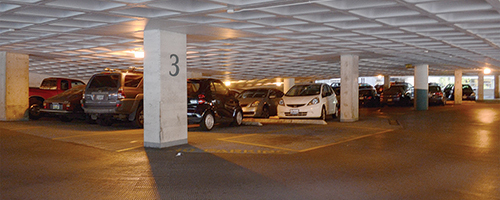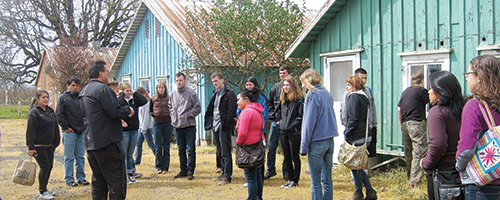Anyone who drives to campus has at one time or another experienced difficulty finding a parking spot. It’s not uncommon for parking lots to fill up quickly, forcing drivers to roam the Park Blocks searching for an empty spot. Competing with renters and visitors to local businesses who park their cars on the street, students are often challenged with finding a place to put their vehicles.
Campus parking hits max
[portfolio_slideshow id=48844]
Anyone who drives to campus has at one time or another experienced difficulty finding a parking spot. It’s not uncommon for parking lots to fill up quickly, forcing drivers to roam the Park Blocks searching for an empty spot.
Competing with renters and visitors to local businesses who park their cars on the street, students are often challenged with finding a place to put their vehicles.
In the coming years, that challenge is going to get worse. In fact, it’s going to get twice as hard, judging by the number of parking spots the university plans to offer.
Currently, the university provides nine parking garages and five parking lots on campus—about 60 percent permit parking and 40 percent hourly/daily parking, said Sarah Renkens, director of Transportation and Parking Services at Portland State. There are about 4,700 parking spaces on campus, according to a 2010 estimate from the university.
The university is forecasting and planning for dramatic growth by the year 2025.
“The way we see it is that PSU has to grow to about 40,000 students from the current 29,000,” PSU President Wim Wiewel said in a recent interview with Oregon Public Broadcasting.
Enrollment poised to spike, yet no change in parking planned
With the rise in enrollment the demand for parking spaces will increase, but because of limited spaces and the high cost of building new parking complexes, adding new lots and garages may not be plausible, Renkens said.
“Since land on or near campus is limited, and it’s extremely expensive to build parking ($30,000–40,000 per space for an above-ground parking garage), we do not currently have plans to build more parking on campus,” she explained.
The city of Portland has a similar stance on the upcoming increase in student need for parking.
“The city does not have any plans to increase parking capacity in the PSU area, either through the addition of on-street parking spaces or public garages,” said Sara Schooley, parking policy coordinator for the Portland Bureau of Transportation.
City focuses on turnover instead
The City of Portland’s main focus for the PSU area is to keep existing spots open. The idea is that spots with shorter time limits will circulate more vehicles and allow more people access to parking spots.
“Currently, the city relies on time limits to provide open spaces. For example, a space with a two-hour time limit would have a greater turnover rate than a space with a five-hour time limit and would therefore have more times when it is available. Pricing is another method to provide open spaces. Currently, the City Council has set the on-street parking prices at $1.60 for the area around PSU,” Schooley said.
University promotes ‘alternative’ transportation
Instead of constructing more costly parking facilities that take up the limited land around campus, the university is looking to reduce dependency on driving.
In 2010, PSU unveiled a University District Framework Plan that outlined PSU’s goals and strategies to create a more sustainable environment over the next 20 years.
The plan is to “reduce the impact of parking on the University District by reducing parking ratios, relocating the majority of parking to the campus edge and taking advantage of the district’s topography to integrate parking into buildings. Together these measures will help reduce traffic congestion and greenhouse gas emissions and promote the use of alternate forms of transportation.”
Reducing the current parking spaces from one space per 1,000 gross square feet to 0.5 spaces per 1,000 will reduce the number of available spots, decreasing parking congestion and encouraging commuters to take other means of transportation to PSU.
For ease and availability, both Transportation and Parking Services at PSU and the Portland Bureau of Transportation advocate alternate means of getting to campus.
“The first piece of advice would be to switch from driving downtown to taking some form of active transportation: bus, streetcar, MAX, bike or foot,” Schooley said.
“PSU has done a great job in encouraging students and staff to use public transportation options. The MAX, streetcar and many buses run to PSU. Biking is also a great way to get to PSU—you don’t have to worry about parking, it’s free (once you have a bike) and you get your workout taken care of!” she said.
PSU has tried to decrease demand for existing parking by subsidizing transit passes, installing bike parking and working with car-share companies (Zipcar, Car2Go, Getaround, et cetera) to ensure there are many car-share vehicles on or near campus.
“Another way we work to maintain or decrease demand is to price parking based on location and increase rates to remain in line with non-PSU facilities in the area,” Renkens said. “We strongly encourage students to find a way to get to campus other than driving alone.
“Portland has a great transit system that reaches all over the metro area, and our office staff can help students plan a route to and from campus. Additionally, there are many great routes for bicycling to campus, and the Bike Hub staff can assist with route planning for commutes by bike.”






Your “prosocial” transportation policy has made RESIDENTIAL parking in my adjacent neighborhood a near impossibility. Why? Because PSU is a commuter campus, which means people live in cheaper (much cheaper) Washington and Clackamas counties, drive their cars to adjacent neighborhoods, such as mine (Lair Hill), then take the free streetcar to classes.
This is not a prosocial policy. This is a financially advantageous policy for PSU, thinly disguised as a prosocial policy. What would be prosocial is a comprehensive commuting policy that didn’t depend on the very old area neighborhoods offsetting some escalating university costs.
Our home was built in 1884 and has no offstreet parking. I work at an area hospital that does have adequate employee parking during the evening hours. During daytime hours, however, I remain a virtual prisoner here, because if I leave home, I am unable to find a parking space within reasonable walking distance when I return. Instead, I find that some commuter has parked there. I am a sixty year old woman with a collapsed vertabra. My 93 year old father lives here.
Oh, yes, as have the other area streets also done, we are pursuing permit parking through the city. We will likely receive it. And you will still be faced with a lack of parking facilities.
Who benefits from all this, in the end?
The city coffers, I would guess. Not my family or your students or even PSU, in the end, because you are still going to have to provide parking facilities at some point, albeit for much more money than it would have cost had you erected them when building materials were less.
Sincerely,
Barbara Anne Dickie